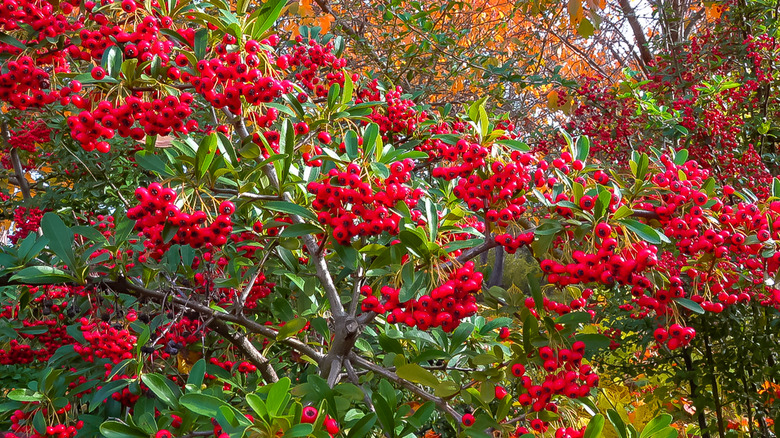Pyracantha coccinea, or firethorn bush, has been introduced to North America by nursery trade and planted throughout the U.S. While its bright red berries are a beautiful addition to any yard, firethorn bush is classified as an invasive species in select U.S. states, including Texas, Georgia, Virginia, Florida, and California. It poses a risk to our native ecosystems as it can outcompete at-risk native species and impact native wildlife that cannot forage from this plant. People are attracted to this semi-evergreen shrub mainly because of the bright red berries. However, while the berries provide food for birds, the birds end up dispersing the seeds, leading to the inevitable spread of this non-native plant. While adding this beautiful plant to your yard may be tempting, there are some important considerations.
Gorgeous? Yes. Dangerous for our native ecology? Also yes. Invasive species pose significant threats to native ecosystems and biodiversity. These invasive plants can cause rare, crucial native species to go extinct, thus affecting the entire ecosystem and food chain. Unfortunately, while a firethorn bush is a stunner in the garden, it can be detrimental to the local ecology. Since birds disperse the seeds, there is no way to control the spread once planted. Thankfully, native species attract birds as well and don’t pose a threat to our local ecosystems. Native plants can bring beauty to your yard while benefiting local wildlife and fighting habitat loss.
What is the firethorn bush?

Firethorn bush is a semi-evergreen upright bush often used as a hedge or trellised vine and can grow from 6 to 18 feet tall and wide. Part of the allure is the white blossoms that blanket the plant during the spring, turning into scarlet red berries in the fall. Firethorn bush is a member of the rose family and is native to Southern Europe. However, its range spreads as far east as Iran. Introduced in the U.S., it can be found in disturbed sites, prairie and coastal environments, and roadsides. However, it has very sharp thorns, so it is sometimes trained to be a privacy hedge or grow on an espalier. The thorns can pose a significant safety risk for pets or children, as they are known to cause swelling and infection around the puncture wounds.
It is tolerant of hot and dry conditions, clay soil, drought-tolerant, and even mildly salt-tolerant. Additionally, non-native shrubs like firethorn bushes can be attractive to gardeners because they are often low-maintenance and drought-tolerant. However, this also means they can easily escape your yard and thrive in wild areas with few resources. While it may seem counterintuitive because they provide food for birds, they cause more damage to the local environment than good and contribute to further biodiversity loss and ecological degradation.
What to plant instead: buttonbush
It can be disappointing to say goodbye to beautiful bird-loving plants in the name of conservation and biodiversity — even though it’s a good deed, we’re allowed to be a little sad about it. If your goal is to attract birds to your garden, there are plenty of native plants that do this and look equally breathtaking. You are more likely to attract birds to your yard using native plants than invasive ornamentals because our local birds have co-evolved with these native plants and depend on them to survive.
An excellent bird magnet and gorgeous replacement for a firethorn bush is the native buttonbush or Cephalanthus occidentalis. Buttonbush is a beautiful native species with a similar growth habit to firethorn and incredible globed white flowers that look like the most precious little puffballs or pincushions you’ve ever seen! Like the firethorn bush, the buttonbush has glossy dark green leaves, grows to about the same height, and is a stunning, showy ornamental bush that blows the invasive firethorn bush out of the water. The nectar will attract butterflies, bees, hummingbirds, and other pollinators, and the fruit will attract incredible and rare birds to your yard. Other than buttonbush, there are lots of other native species that attract birds and make an excellent replacement for firethorn bush. Some examples are yaupon holly, firebush, coral honeysuckle, wild currant, California holly, and wild evergreen sumac.